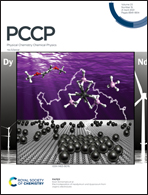Me-graphane: tailoring the structural and electronic properties of Me-graphene via hydrogenation†
Abstract
Graphene-based materials (GBMs) are a large family of materials that have attracted great interest due to potential applications. In this work, we applied first-principles calculations based on density functional theory (DFT) and fully atomistic reactive molecular dynamics (MD) simulations to study the structural and electronic effects of hydrogenation in Me-graphene, a non-zero bandgap GBM composed of both sp2 and sp3-hybridized carbon. Our DFT results show the hydrogenation can tune the electronic properties of Me-graphene significantly. The bandgap varies from 0.64 eV to 2.81 eV in the GGA–PBE approach, passing through metallic ground-states and a narrower bandgap state depending on the hydrogen coverage. The analyses of structural properties and binding energies have shown that all carbon atoms are in sp3 hybridization in hydrogenated Me-graphene with strong and stable C–H bonds, resulting in a boat-like favorable conformation for fully-hydrogenated Me-graphene. Our MD simulations have indicated that the hydrogenation is temperature-dependent for Me-graphene, and the covalent adsorption tends to grow by islands. Those simulations also show that the most favorable site, predicted by our DFT calculations, acts as trigger adsorption for the extensive hydrogenation.



 Please wait while we load your content...
Please wait while we load your content...